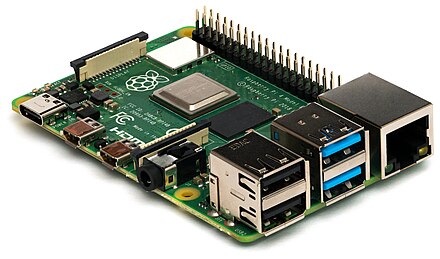
A Raspberry Pi is a series of single-board computers (SBCs). They were developed in the United Kingdom by the Raspberry Pi Foundation in association with Broadcom. These computers are small and relatively cheap. They are modular and the design is open. These computers were originally developed in order to promote computer science in schools. Computer and electronic hobbyists seized upon these computers. The first generation of Pi computers dates to 2012. Successive versions followed and the latest version is version 4. In addition a number of smaller, more basic version have been released including the Raspberry Pi Zero, and the Raspberry Pi Pico (which is more of a micro controller). These computers have an SD chip/card as a memory device and can operate most operating systems, although Linux is the favourite. They also have an Ethernet port, USB ports, a GPIO connector and in some cases HDMI port(s). The processor speed on the Pi 4 is about 1.5 GHz. The process or can be overclocked and this results in high chip temperatures, so one of the first modifications to do is to put on a heat sink.
There are modules (or HATS - Hardware Attached on Top) available that can be installed on the Pi including an HD camera, digital television, infrared cameras, touch screen displays and so on. One can design and make one's own customized HAT. There are even HATS that can be used as a software defined radio (SDR). A favourite set of HATS are weather sensors for a remote weather station. Robots and rovers can be made. High altitude balloon experiments also make use of sensors attached to a Pi.

There are other SBCs around, such as banana pi. There are also microcontroller kits for hobbyists such as the Arduino. There is an interesting trademark history about Arduino summarized in Wikipedia, but that is another story. Arduino has shields (which are like HATs) which can be used for many different purposes including 3D printing, satellite navigation, robots, servo motor control, Ethernet, LCDs, breadboarding etc. It has an IDE in Java. TenTec, a well-known amateur radio manufacturer, actually markets some amateur transceivers based on Arduinos: for instance the 507 Patriot SSB& CW QRP and 506 Rebel CW Tx/Rx .
The Yellowknife Amateur Radio Society is just starting to experiment with these. One of our initial projects will be to set up a remote weather station with a 2 m APRS link.
Sources:


